Click on images to enlarge

habit (Photo: Sheldon Navie)
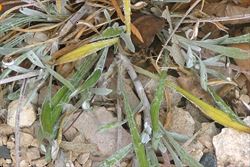
spreading aboveground stems (Photo: Sheldon Navie)
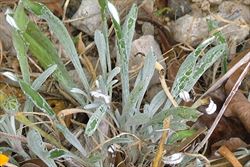
leaves (Photo: Sheldon Navie)
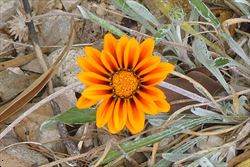
flower-head (Photo: Sheldon Navie)
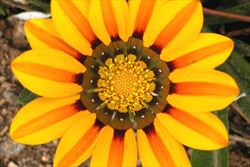
close-up of flower-head (Photo: Greg Jordan)

close-up of floral bracts (Photo: Greg Jordan)

close-up of seed (Photo: Greg Jordan)
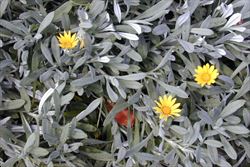
Gazania rigens var. leucolaena (Photo: Forest and Kim Starr, USGS)

Gazania hybrids (Photo: Sheldon Navie)
Scientific Name
Gazania rigens (L.) Gaertn.
Synonyms
Gazania splendens hort. ex Hend. & A.A. Hend.
Gorteria rigens L.
Family
Asteraceae (Queensland, New South Wales, the ACT, Victoria, Tasmania, Western Australia and the Northern Territory)
Compositae (South Australia)
Common Names
coastal gazania, gazania, treasure flower, treasure-flower, treasureflower
Origin
Native to southern Africa (i.e. Mozambique and South Africa).
Cultivation
A very popular and widely grown garden plant. Numerous cultivars and hybrids of coastal gazania (Gazania rigens) are grown in Australia. Common cultivars include 'Buccaneer', 'Chansonette' and 'Yellow Buttons', while the Daybreak and Sunshine Giant hybrids are also popular.
In addition two smaller-flowered varieties, with flower-heads less than 4 cm across, are also cultivated (i.e. Gazania rigens var. leucolaena and Gazania rigens var. uniflora). Gazania rigens var. leucolaena has leaves with white cobwebby hairs on both surfaces, while Gazania rigens var. uniflora has upper leaf surfaces that are green and virtually hairless.
Naturalised Distribution
Widely naturalised in the coastal districts of southern and eastern Australia (i.e. in southern and central Queensland, eastern New South Wales, southern Victoria, southern South Australia and south-western Western Australia. Also occasionally naturalised in south-western New South Wales.
Habitat
Coastal gazania (Gazania rigens) is a weed of coastal sand dunes and headlands, urban bushland, gardens, lawns, roadsides, disturbed sites and waste areas in temperate and sub-tropical regions.
Habit
A long-lived (i.e. perennial) herbaceous plant usually only growing 15-30 cm tall.
Distinguishing Features
- a long-lived herbaceous plant (15-30 cm tall) with short spreading stems.
- its alternately arranged leaves (4-12 cm long and 5-40 mm wide) are variable in shape.
- they can be long and narrow with entire margins, or deeply-divided into several narrow segments.
- these leaves have green and hairless upper surfaces and whitish hairy undersides.
- its large daisy-like flower-heads (7-12 cm across) are borne singly on long stalks.
- the 'petals' are usually bright orange, bronze or yellow with a black base marked with a white dot.
- its 'seeds' (about 4 mm long) are densely covered in long hairs.
Stems and Leaves
The branched stems are relatively short and low-growing (i.e. decumbent).
The alternately arranged leaves (4-12 cm long and 5-40 mm wide) are often densely clustered along the stems and are highly variable in shape. They are often long and narrow (i.e. narrowly-oblanceolate) with entire margins, but can also be deeply-divided into several narrow segments (i.e. irregularly pinnatisect). Their upper surfaces are usually green and hairless, while there lower surfaces are densely covered in white hairs (i.e. white tomentose). The leaf tips are pointed (i.e. acute).
Flowers and Fruit
The daisy-like flower-heads (i.e. capitula) are borne singly on stalks (i.e. peduncles) that originate in the leaf forks (i.e. axils). These stalks (i.e. peduncles) are upright (i.e. erect) and 8-20 cm long. The relatively large and showy flower-heads (7-12 cm across) have numerous 'petals' (i.e. ray florets). These 'petals' (3-5 cm long) are narrowly oval to elongated in shape (i.e. narrowly elliptic to oblanceolate) and variable in colour. They are usually bright orange, bronze or yellow with a black base marked with a white dot. At the base of each flower-head (i.e. capitulum) there is a cup-like structure (i.e. involucre) 10-15 mm across. This is made up of two or three rows of elongated (i.e. lanceolate) green bracts (i.e. involucral bracts). At the centre of the flower-heads there are numerous tiny tubular flowers (i.e. disc florets) arranged on a flattened base (i.e. receptacle). These florets are orange or yellow in colour and contain both male and female flower parts (i.e. they are bisexual). Flowering occurs throughout most of the year.
The 'seeds' (i.e. achenes) are egg-shaped (i.e. obovoid) and densely covered in long hairs (i.e. they are villous). These 'seeds' (about 4 mm long) also have a row (i.e. pappus) of numerous hair-like scales (2-3 mm long) that are usually obscured by the long hairs.
Reproduction and Dispersal
This species reproduces mainly be seed. However, it can also spread vegetatively by pieces of its creeping stems, which can take root and form new plants.
Coastal gazania (Gazania rigens) is predominantly dispersed to new areas as a result of deliberate plantings in gardens. The hairy seeds may be spread from these plantings by wind, animals, vehicles and in clothing. Seeds and stem pieces are also dispersed in dumped garden waste.
Environmental Impact
This species is regarded as an environmental weed in South Australia, New South Wales and Victoria and as a "sleeper weed" in other parts of southern and eastern Australia. It prefers sandy environments and most commonly invades coastal sand dunes and headlands, particularly in exposed and sunny positions. Coastal gazania (Gazania rigens) can severely alter the vegetation structure in plant communities by suppressing native plants. It is also often difficult to permanently eradicate from coastal environments, because it is often reintroduced into managed areas from nearby residential gardens. In 2005, the weedy gazanias were listed in one research publication as among the ten most serious invasive plants currently being sold by Australian nurseries.
In South Australia, coastal gazania (Gazania rigens) is found growing around nearly all townships and settlements along the coast. It is common on the Yorke Peninsula, the Eyre Peninsula, in the Southern Lofty and South East regions, along the top of Spencers Gulf, around St Vincent Gulf and along the Southern Fleurieu Peninsula coastline. Coastal gazania (Gazania rigens) is also listed as an invasive garden plant in the Greater Adelaide Region and is a weed of Marino Conservation Park in suburban Adelaide.
In New South Wales it grows mainly on coastal dunes and roadsides along the central coast, from southern Sydney to Gosford. However, it was also listed as a problem weed during the recent North Coast environmental weed survey and is becoming a problem along the South Coast too.
Coastal gazania (Gazania rigens) has also invaded dry coastal vegetation, heathlands, heathy woodlands, lowland grasslands and grassy woodlands in Victoria. In 1992 it was widely distributed in medium to large populations, and was considered to be a potential threat to one or more vegetation formations, in this state.
Other Impacts
This species can also invade pastures in coastal districts.
Legislation
Not declared or considered noxious by any state government authorities.
Management
For information on the management of this species see the following resources:
- the March 2006 edition of Under Control, which is available online at http://www.dse.vic.gov.au.
Similar Species
Coastal gazania (Gazania rigens) is very similar to gazania (Gazania linearis ). Hybrids between the two species (and possibly also hybrids involving other species) are also thought to be present in naturalised populations. The following differences can be used to distinguish between typical plants of both species, however intermediate forms may be common in some areas:
- coastal gazania (Gazania rigens) has short creeping aboveground stems and forms large spreading clumps. Its leaves are alternately arranged or densely clustered along these stems. Its 'petals' (i.e. ray florets) are usually bright orange to deep yellow with a black base marked with a white spot.
- gazania (Gazania linearis) has very short creeping underground stems (i.e. rhizomes) and forms smaller clumps. Its leaves are borne in a rosette at ground level (i.e. they are radical). Its 'petals' (i.e. ray florets) are often yellow with a reddish central stripe and a black base, but may be orange, or bronze or red.
Coastal gazania (Gazania rigens) is also relatively similar to capeweed (Arctotheca calendula) and white arctotis (Arctotis stoechadifolia). These species can be distinguished by the following differences:
- coastal gazania (Gazania rigens) has elongated entire to deeply lobed (i.e. entire to pinnatisect) leaves with green or greyish upper surfaces and whitish hairy undersides. Its flower-heads are very large (6-12 cm across) with yellow or orange centres and 'petals' (i.e. ray florets) 30-50 mm long. These 'petals' are various colours and usually have black bases.
- capeweed (Arctotheca calendula) has elongated deeply lobed (i.e. lyrate-pinnatisect) leaves with green upper surfaces and whitish hairy undersides. Its flower-heads are relatively large (2-6 cm across) with dark purplish or black centres and 'petals' (i.e. ray florets) 10-25 mm long. These 'petals' are yellow with darker yellow bases and greenish or purplish coloured undersides.
- white arctotis (Arctotis stoechadifolia) has elongated (i.e. lanceolate) leaves with the toothed (i.e. serrate) or deeply lobed (i.e. lyrate-pinnatisect) margins and greyish hairy surfaces. Its flower-heads are relatively large (4-6 cm across) with dark purplish or black centres and 'petals' (i.e. ray florets) 25-30 mm long. These 'petals' are creamy-white to light yellow with darker yellow bases (sometimes pink or purplish throughout) and maroon or mauve undersides.

